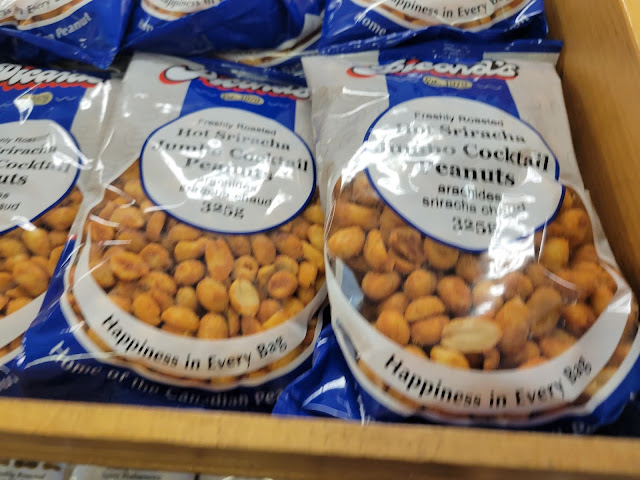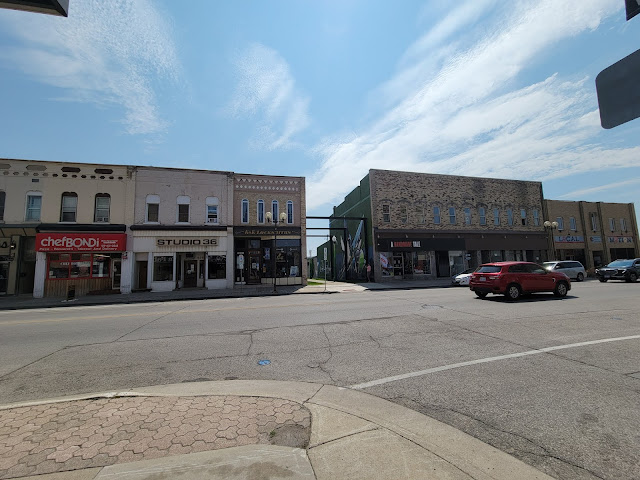On Monday we packed up the car for an overnight car trip, the first day trip that involved staying in a hotel in the last eighteen months. Click here for the overview.
This was what we ended up doing. Monday's weather was unbearably hot even for John and I so it also influenced some of our choices. Tuesday was a rainy day but it didn't really impact us.
We skipped the Frisky Beaver winery, due to a detour that led us in circles in Simcoe. We also didn't bother with the winery in St. Thomas.
In St. Thomas we didn't manage to see all the sights we had planned, partly timing and partly the heat.
Mid July would be perfect to see the lavender in bloom.
Some spots that need more investigation. Burning Kiln, Inasphere, Frisky Beaver, Villa Nova, Wooden Bear are wineries. Blueberry Hill has a winery and walking trails. Whistling Gardens is a botanical garden. Applehill is a lavender farm. Ramblin Road is a brewery farm, New Limburg is a brewery. WTFD Antiques in in Waterford. Port Dover Beach. Second Mouse is a cheese boutique.
Unplanned stop in Windham. Incredible prices, in fact, we made a second stop in Woodstock on Tuesday.
Peanuts were introduced to the Southwestern Ontario’s sandy soils of Norfolk County in 1979, by the Picard Family. Early production had its ups and downs, learning the specialty crops needs and increasing production to a commercial scale with specialized equipment and good farming practices. As with most farming businesses there was great risk and an early frost in 1982, was devastating to the fledgling industry. In the years following the frost, determination and hard work began to bear fruit. The Picard family peanut business focused on value-added food products to advance and expand the peanut business. From the early days of peanut clusters, peanut brittle and beernuts – the product line grew, during the 80’s and early 90’s to over 150 products focused on peanuts and the expanding confectionery product line. With this unique and flavourful expanded product line, retail locations were added across Southwestern Ontario. The now infamous blue barns became the focal point of unique peanut and snack products, direct from the manufacturing facilities of the Picard family.
We drove through Tillsonburg and stopped at the old train station, now a gallery.
This was mainly a bathroom break.
Cute, made by the kids' day camps.
We planned to spend most of our time here in St. Thomas known as the Railway City.
The railway has been part of St. Thomas since the completion of the London and Port Stanley Railway in 1856 and since then, more than 26 railways have passed through the city. This provided the foundation for the birth of St. Thomas due to the provision of employment and, subsequently, the income to sustain the community.
The Canada Southern Station (CASO Station) in St Thomas Ontario was the largest of 31 railway stations built in Ontario during the 1870s by Canada Southern Railway Company (CSR). The station was constructed between June 1871 and April 1873.
CASO Station was remarkably large for a town the size of St Thomas (the community didn’t become a city until 1881). However, the building needed to be big enough to accommodate both the town’s passenger station (ground floor) and the corporate headquarters of CSR (upper floor).
The building’s grandeur was impressive. The 1882 publication Picturesque Canada reported that the station was “one of the finest in the Dominion, and reminds one of the large structures in Chicago and New York.”
The Elgin County Railway Museum is located in the former Michigan Central Railroad (MCRR) locomotive repair shops, just south of the Canada Southern (CASO) train station. The 55,000 square foot “shops” building have served as headquarters of the museum since 1988. Locomotive, passenger car, and railway service vehicle repairs and restorations are performed today. Guided tours of the Elgin County Railway Museum are available
year round due to Covid it is only open Thursday and Friday. I would definitely add this museum to my list on a return visit.
The 1913 MCRR shops are the oldest continuously-operating locomotive repair shops in North America.
WHEN I'M BIG Dan & Peter Sawatzky
Touted as Canada's largest railway mural, at an impressive 30ft. tall and 50ft. wide, this mural depicts the aspirations of many children who grew up surround by steam engines and the railway industry in St. Thomas.
Good name for their transit system.
HARVEST Denis Arsenaualt
With the development of the railway in Elgin County came the opportunity for the farming community to get their goods to the national and international markets. The railway helped to make Canada a connected agricultural force.
FOUNDATION OF TOWN & RAIL Paul Membourquette
The Canada Southern Railway was a big part of St. Thomas' rail history from 1872 to 1881. The C.S.R.'s legacy to the community is its historic Talbot Street station, which was created in 1872 as a shortcut through Canada from Chicago to New York.
Jumbo, “The King of Elephants” was tragically killed when he was struck by a Grand Trunk Locomotive in St. Thomas Ontario, on September 15th, 1885. In 1985 on the 100th anniversary of Jumbo’s death, the City of St. Thomas dedicated a 38 ton statue as a tribute to the most famous elephant who ever lived.
If you are going to visit the Elevated Park I suggest you park by the statue, it is only a short walk down King St. to the park and there is no parking at the park for some odd reason. BTW our GPS wouldn't recognize the address 1 Center St. for the park.
Looking at the park from the car.
WALK WITH ELEPHANTS
Painted on a former rail underpass, this mural beautifully combines colour and the symbolism of good luck and positive energy.
The CSR single-track, timber-trestle over Kettle Creek at St. Thomas was completed in February, 1872. The trestle was made of framed timber, carried a single track, and was 28m (92 feet) high and 416 m (1,365 feet) long. It consisted of 14 Howe truss deck spans supported on timber bents. The longest span over Kettle Creek was 13.7 m (45 feet). In 1883, the year after the CSR was leased to the Michigan Central Railroad, the timber trestle was replaced with a double-tracked, metal structure 425 m (1,395 feet) long and 28.3m (93 feet) above the creek bed.
The design for a replacement structure over Kettle Creek was underway in 1928. The general contract for the work was awarded on April 25, 1929. The entire project cost $689,000 (at the time). The steel was fabricated by the Canadian Bridge Company in Walkerville, Ontario.
It has stood at the western edge of the city since 1929, a recognized engineering marvel of its era which, at its peak carried some 50 trains each day, both freight and passenger.
The last train rolled across the double-tracked bridge in 1996 and it then sat idle for 17 years while demolition firms sent proposals to its owner — a local land developer — to have it dismantled.
But the developer wanted it to survive and offered it free to the City of St. Thomas. St. Thomas said No Thanks, thinking about future maintenance costs.
However, an organization of local volunteers called On Track stepped forward in 2013 and purchased the unique bridge for $116,000 and started a campaign to convert the trestle to Canada’s first elevated park — similar to the High Line Linear Park in New York City.
It is lined with benches and art.
Entitled Fear Not The Wind, the artwork is an over-size, functional weathervane.
“Because it’s a windy environment up there, the artist came up with the idea of using that wind to make the sculpture move,” explained Serge Lavoie, president of On Track St. Thomas. “So, a big, overgrown weather vane was the answer. You go to old-fashioned gardens and they put in weather vanes or sun dials and he came up with a weather vane for this garden and I think it’s a cool idea.”
It was time to move on to our hotel in Ingersoll about 30 km away.
We stayed at the Elm Hurst Inn and Spa.
James Harris erected the James Harris Cheese Factory on the grounds of what is now Elm Hurst Inn & Spa in 1865.
One year later, the factory was the birthplace of the 7,300 pound cheese, co-manufactured by local producers to put Ingersoll on the map. The famous ‘Mammoth Cheese’ travelled to exhibitions in Toronto, Sarasota, New York, Paris France and London, England.

The Elm Hurst mansion was built in 1872 as the personal residence of James Harris and family. A fine example of the Gothic Revival style, it remained a stately family home for more than a century.
The last Harris heir sold the property in the mid 1970s, and the house was transformed into a popular dining establishment that opened in 1979. An addition was added to the rear of the original structure five years later, with the 49-room Elm Hurst Inn & Spa being built in 1988.
We will do this trip again with time in Port Dover and along the shore with an overnight perhaps in St. Thomas.













































































I'm jealous! Bet it felt good to get out and about. Still too hot here to go anywhere outside. And too Covid to go any where inside. Talked to Paco today. He and family and all of guys at Torres are fine. Protocols really enforced.
ReplyDeleteIt sure did, Carol. It was way too hot out here too so I feel your pain. Glad to hear Paco and all are good.
DeleteSad you couldn´t visit the Tobacco Museum. Same here. We were in Havana and on a guided tour, that skipped this. Bummer.
ReplyDeleteSad you had to skip so much!
Love the cuppa in the field.
Glad to see some things are still for free! And oh. love lavender! We used to have the French market once a year and you could buy sachets of that. Or soap. Hmmmm.
Oh!!! Did you try the ice cream? My sweet tooth wakes up!
"Happiness in Every Bag" sounds very good! In more than one way, according to what you described.
Quite a trip. And Jumbo sure is impressive. Sad what happened to him, of course. Love the mural.
Nice to see free libraries all over - just brought a whole stash to ours :-)
Great art, thank you for sharing this trip - I´m stuck to the balcony...
We can easily plan a trip and go back to see what we missed. I have had lavender ice cream, it is good. I did buy a lavender pillow spray.
DeleteI miss Canada.
ReplyDeleteAnd we miss driving trips into the States. However, we have opened the border to Americans.
DeleteWhat an amazing adventure you undertook after 18 months of no to limited travel. Of special interest to me were the murals of course, the lavender fields with the tea cups, the elephants, including the Jumbo sculpture, and the elevated park. I've seen the High Line in NYC, so I was really impressed with your elevated park. What an incredible way to restore an old railroad line. It is really stunning with all the art sculptures and statues.
ReplyDeleteWhat a fantastic journey you have been on. I am so happy you shared your travels and lovely pictures. We've never been up to those areas so it was a treat to see online. Thanks Jackie
ReplyDelete